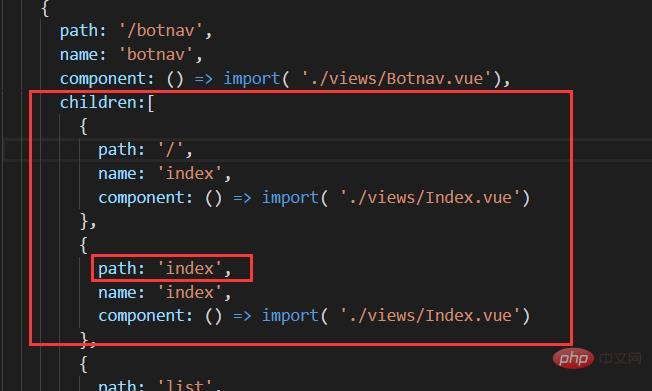What should I do if Vue secondary routing reports an error?
The solution to vue secondary routing error: 1. Check and delete the slash in front of the secondary routing path; 2. Check whether the parent route has a path. If the path is a slash, redirect directly matches page2; 3. Do not use redirect and set the default displayed sub-route path to empty.

#The operating environment of this tutorial: Windows 10 system, Vue version 3, Dell G3 computer.
What should I do if vue secondary routing reports an error?
One of the reasons why the secondary route jump in vue is unsuccessful
When the secondary route has a specific path, it is not added in front Slash/

vue secondary route does not display the page bug
If the parent route path is/ Then the redirect can directly match page2
{
path: '/',
component: () => import('../view/analyse/analyse.vue'),
redirect: '/page2', //这里前面加不加/都行
children: [
{
path: 'page1',//这里前面加不加/都行
component: () => import('../view/analyse/page/page1')
},
{
path: 'page2',//这里前面加不加/都无所用
component: () => import('../view/analyse/page/page2')
},
]
}If the parent route has a path, the redirect must be preceded by the parent route, otherwise it will become a /child path and the child route will need to match /parent path/child path by default
{
path: '/analyse',
component: () => import('../view/analyse/analyse.vue'),
redirect: '/analyse/page2',//这里前面加不加/都行,必须父路由/子路由
children: [
{
重点::::::::
//这里前面不能加 /不然就会匹配成/page1
path: 'page1', 实际他等同于 /analyse/page1
//这里前面不能加 /不然就会匹配成/page1
component: () => import('../view/analyse/page/page1')
},
{
path: 'page2', //这里前面不能加 /
component: () => import('../view/analyse/page/page2')
},
{
path: 'page3', //这里前面不能加 /
component: () => import('../view/analyse/page/page3')
}
]
}If you don’t use redirect, the path of the sub-route displayed by default is empty.
{
path: '/', 或者 path: '/analyse',
component: () => import('../view/analyse/analyse.vue'),
children: [
{
path: '' , path为空就可以了
component: () => import('../view/analyse/page/page1')
},
{
path: 'page2',
component: () => import('../view/analyse/page/page2')
},
]
}The parent page needs to have a placeholder tag to display the content of the sub-route
<div class="content"><router-view /></div>
Recommended learning :《vue.js video tutorial》
The above is the detailed content of What should I do if Vue secondary routing reports an error?. For more information, please follow other related articles on the PHP Chinese website!

Hot AI Tools

Undresser.AI Undress
AI-powered app for creating realistic nude photos

AI Clothes Remover
Online AI tool for removing clothes from photos.

Undress AI Tool
Undress images for free

Clothoff.io
AI clothes remover

Video Face Swap
Swap faces in any video effortlessly with our completely free AI face swap tool!

Hot Article

Hot Tools

Notepad++7.3.1
Easy-to-use and free code editor

SublimeText3 Chinese version
Chinese version, very easy to use

Zend Studio 13.0.1
Powerful PHP integrated development environment

Dreamweaver CS6
Visual web development tools

SublimeText3 Mac version
God-level code editing software (SublimeText3)

Hot Topics
 1663
1663
 14
14
 1420
1420
 52
52
 1315
1315
 25
25
 1266
1266
 29
29
 1239
1239
 24
24
 How to use bootstrap in vue
Apr 07, 2025 pm 11:33 PM
How to use bootstrap in vue
Apr 07, 2025 pm 11:33 PM
Using Bootstrap in Vue.js is divided into five steps: Install Bootstrap. Import Bootstrap in main.js. Use the Bootstrap component directly in the template. Optional: Custom style. Optional: Use plug-ins.
 How to add functions to buttons for vue
Apr 08, 2025 am 08:51 AM
How to add functions to buttons for vue
Apr 08, 2025 am 08:51 AM
You can add a function to the Vue button by binding the button in the HTML template to a method. Define the method and write function logic in the Vue instance.
 How to use watch in vue
Apr 07, 2025 pm 11:36 PM
How to use watch in vue
Apr 07, 2025 pm 11:36 PM
The watch option in Vue.js allows developers to listen for changes in specific data. When the data changes, watch triggers a callback function to perform update views or other tasks. Its configuration options include immediate, which specifies whether to execute a callback immediately, and deep, which specifies whether to recursively listen to changes to objects or arrays.
 What does vue multi-page development mean?
Apr 07, 2025 pm 11:57 PM
What does vue multi-page development mean?
Apr 07, 2025 pm 11:57 PM
Vue multi-page development is a way to build applications using the Vue.js framework, where the application is divided into separate pages: Code Maintenance: Splitting the application into multiple pages can make the code easier to manage and maintain. Modularity: Each page can be used as a separate module for easy reuse and replacement. Simple routing: Navigation between pages can be managed through simple routing configuration. SEO Optimization: Each page has its own URL, which helps SEO.
 React vs. Vue: Which Framework Does Netflix Use?
Apr 14, 2025 am 12:19 AM
React vs. Vue: Which Framework Does Netflix Use?
Apr 14, 2025 am 12:19 AM
Netflixusesacustomframeworkcalled"Gibbon"builtonReact,notReactorVuedirectly.1)TeamExperience:Choosebasedonfamiliarity.2)ProjectComplexity:Vueforsimplerprojects,Reactforcomplexones.3)CustomizationNeeds:Reactoffersmoreflexibility.4)Ecosystema
 How to return to previous page by vue
Apr 07, 2025 pm 11:30 PM
How to return to previous page by vue
Apr 07, 2025 pm 11:30 PM
Vue.js has four methods to return to the previous page: $router.go(-1)$router.back() uses <router-link to="/" component window.history.back(), and the method selection depends on the scene.
 How to reference js file with vue.js
Apr 07, 2025 pm 11:27 PM
How to reference js file with vue.js
Apr 07, 2025 pm 11:27 PM
There are three ways to refer to JS files in Vue.js: directly specify the path using the <script> tag;; dynamic import using the mounted() lifecycle hook; and importing through the Vuex state management library.
 How to use vue traversal
Apr 07, 2025 pm 11:48 PM
How to use vue traversal
Apr 07, 2025 pm 11:48 PM
There are three common methods for Vue.js to traverse arrays and objects: the v-for directive is used to traverse each element and render templates; the v-bind directive can be used with v-for to dynamically set attribute values for each element; and the .map method can convert array elements into new arrays.




